When is the Mix Ratio for Spectrum Liquid Weed and Feed
If you are an avid gardener, finding the best weed killer for your lawn or garden can be a daunting task. Every year, thousands of people across the United States use 2, 4-D weed killers to control weeds in their yards and gardens. It's a popular product because it kills just about any kind of unwanted plants with just one application.
But what is 2, 4-D weed killer? What are its risks? How do you safely use it around your family and pets?
This guide to 2, 4-D weed killer will answer these questions for you, providing tips on how to best apply this product without harming yourself or others.
What is 2, 4-D Weed Killer?
2, 4-D weed killer is an herbicide that kills broadleaf weeds, like purslane, in a selective way. It kills them by changing the way the plant cells grow, making them grow uncontrollably so that the plants can't keep up with that growth and ultimately die. It is classified as an auxin-type synthetic herbicide because it makes cells in plant tissues multiply so quickly.
This herbicide was first used in the United States in the 1940s. It can be found in multiple chemical forms, the toxicity of which depends on the form (as does its safety for the environment). It can be found in esters, salts, and acids and is often mixed with other herbicides to control weeds.
You can purchase 2, 4-D as a concentrated or ready-to-use liquid that requires no mixing. You can also buy it as a dust, granule, or liquid, with thousands of different 2, 4-D products sold in the United States. It kills broadleaf weeds but does not harm grasses.
What Weeds Does 2, 4-D Weed Killer Kill?
2, 4-D is an effective weed killer for most kinds of plants. It can be used on lawn and ornamental turf along with patio areas, drainage ditch banks, driveways, fences, and more. This herbicide can kill all kinds of weeds you might want to get rid of, including:
- Goldenrod
- Purslane
- Alder
- Toadflax
- Canada thistle
- Tumbleweed
- Velvet leaf
- Red clover
- Ragweed
- Sagebrush
- Nettle
- Virginia Creeper
- Coffeeweed
- Pepperweed
- Wild carrot
- Pennycress
- Jewelweed
- Wild parsnip
- Sweet clover
…and much more. The only grass that 2, 4-D is listed as being able to kill is nutgrass, likely a species that you aren't working hard to cultivate in your lawn!
The sad news about 2, 4-D is that it is not going to be an effective option for getting rid of crabgrass. Since crabgrass is technically a species of grass, 2, 4-D weed killer will not touch it; instead, check out our list of best crabgrass killers. In addition, while 2, 4-D works against standard clover, you will see better results using a 3-way herbicide such as Speedzone (which uses 2 4 D as a main ingredient, but also includes a few others).
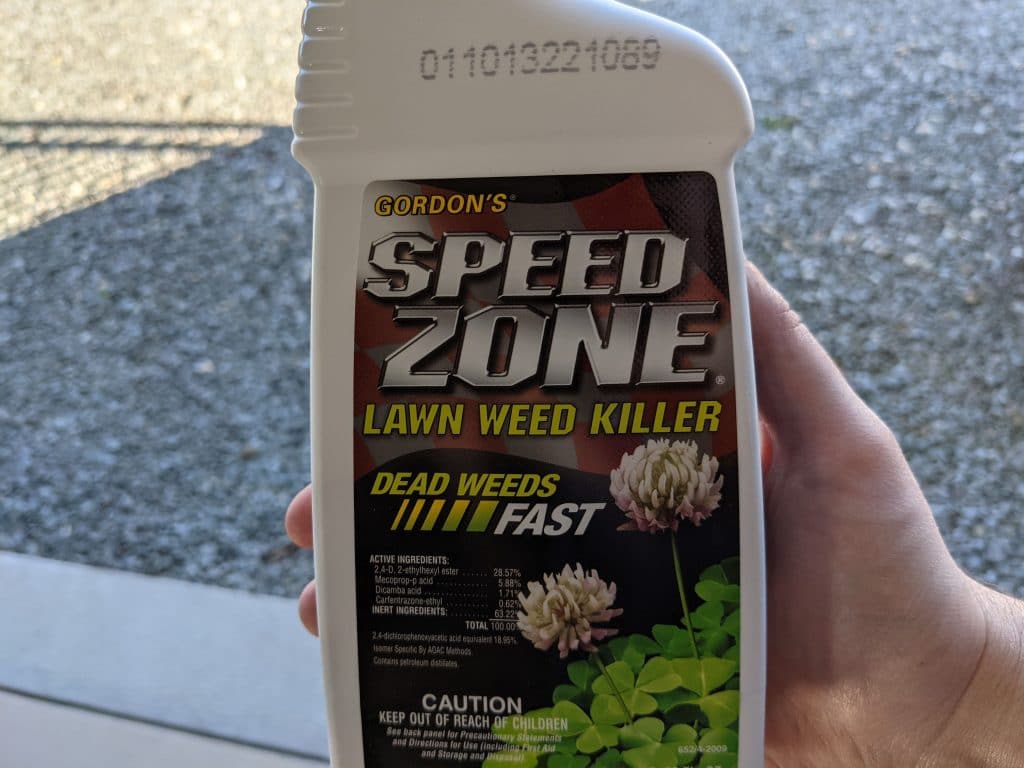
What Kinds of Lawns is it Safe For?
2, 4-D is safe for most lawns since herbicides kill broadleaf weeds without harming your grass. If you spray it on your lawn and follow the proper ratios, you shouldn't have any issue getting rid of non-grass weeds without killing your grass in the process.
This herbicide can be used to kill hundreds of species of weeds in virtually any type of lawn or yard, but it's non toxic to honeybees and other beneficial insects. It can be used on both warm and cool-season grass types.
What Lawns to Avoid
This kind of herbicide is safe for most lawns. The exception, however, is when using 2, 4-D on turfgrass lawns like St. Augustine grass. Although certain products, like Hi-Yield 2, 4-D are listed as being safe, others are not indicated for use on this grass type and can cause damage to it. You may want to use a different herbicide instead.
You also should avoid using 2, 4-D on dormant grasses. For example, using 2, 4-D on dormant Bermuda grass can cause damage to the blades when the plants are in the dormant stage in late winter or early spring.
Mixing Ratio and Application Rate
Consult your package of 2, 4-D weed killers to find out what ratio to mix and apply your product at because instructions vary – each brand has its own mixing ratio that will be indicated on the instructions.
However, they are usually similar. Most require you to mix about 2.5 ounces of 2, 4-D (which equates to about five tablespoons) with one gallon of water. This will treat approximately 400 square feet of yard. You can double the ratio to 5 ounces for every two gallons of water if you want to treat around 800-1000 square feet of space.
Of course, this is not the mixing ratio that you will need to follow for all liquid 2, 4-D brands. For example, Hi-Yield, the first 2, 4-D weed killer product we've reviewed below, requires a mixing ratio of 3-4 fluid ounces (or 6-8 tablespoons) of product mixed with 1-3 gallons of water applied for every square foot.
6 Best 2, 4-D Weed Killers
1. Hi-Yield 2, 4 – D Selective Weed Killer
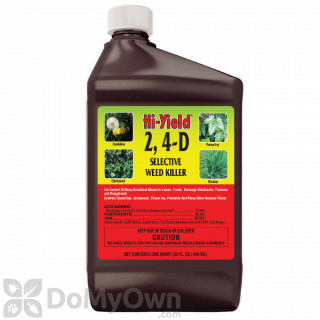
Why DoMyOwn?DoMyOwn.com offers professional-grade herbicides to DIYers while ensuring proper storage of chemicals. Couple that with their impressive customer service and knowledgeable staff, it's the #1 choice.
Hi-Yield is one of the most commonly recommended 2, 4-D weed killers. A post-emergent liquid concentrated herbicide, it can be used in all kinds of places where weeds are actively growing. It is meant to be applied during the warm months when weeds are growing in full force and can control broadleaf plants like honeysuckle, sumac, nettle, alder, poison ivy, and more.
Some perennial weeds, like bindweed, may require multiple applications. It is available in pint, quart, and gallon sizes and contains 11.84% 2, 4-D.
Features and Specs:
- Treats 5450 square feet of turf area
- Must be mixed with water
- For use in lawns, drainage ditch banks, rangelands, pastures, and ponds
Pros:
- Rainfast up to six hours after application
- Kills dozens of types of plants
- Liquid form makes it easy and safe to apply
Cons:
- Can take up to four weeks to see results
2. Q4 Plus Turf Herbicide
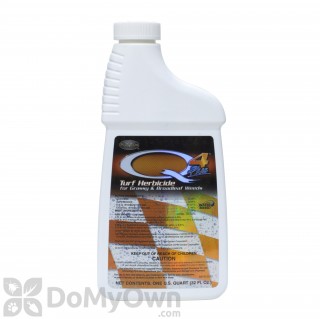
Q4 Plus Turf Herbicide
2,4-D, dimethylamine salt 11.81%, Dicamba, dimethylamine salt 1.49%, Quinclorac 8.43%, Sulfentrazone 0.69%
Q4 Plus is highly selective on cool-season turf grasses. Labeled species include bluegrasses, ryegrass, tall fescues, and bermudagrass.
Why DoMyOwn?DoMyOwn.com offers professional-grade insecticides to DIYers while ensuring proper storage of chemicals. Couple that with their impressive customer service and knowledgeable staff, it's the #1 choice.
Q4 by PBI-Gordon is another 2,4-D product that you might consider using. This option does not contain 2,4-D in exclusivity but also has other weed killers like dicamba mixed in. Because of this, it kills weeds quickly and effectively.
It can be used as a spot treatment or as a broad spectrum application. It is most effective in the later summer and can be applied at a mixture of 2.6-3.0 fluid ounces per one gallon of water to treat about 1000 square feet of cool-season turfgrass (you'll use a bit less for warm-season grasses).
Features and Specs:
- Sold in quart and gallon sizes
- Contains 2,4-D, dimethylamine salt 11.81%, Dicamba, dimethylamine salt 1.49%, Quinclorac 8.43%, Sulfentrazone 0.69%
- Pet safe if used as directed
Pros:
- Rainfast for six hours
- Four week reseeding interval
- Works well on ryegrass, tall fescues, bermudagrass, and bluegrass
Cons:
- Using on bermudagrass, zoysiagrass, and fine fescues can cause temporary lawn yellowing
3. Trimec 992 Broadleaf Herbicide
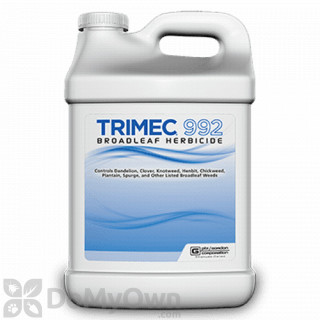
Trimec 992 Broadleaf Herbicide
2,4-D, dimethylamine salt 30.56% Dicamba, dimethylamine salt 2.77% MCPP-P, DMA salt 8.17%
Trimec 992 Broadleaf Herbicide is formulated for the professional with a little more 2,4-D to rapidly give you results you can see, like very fast dandelion curl, while keeping your overall costs of application low.
Why DoMyOwn?DoMyOwn.com offers professional-grade insecticides to DIYers while ensuring proper storage of chemicals. Couple that with their impressive customer service and knowledgeable staff, it's the #1 choice.
Trimec by Gordon's is a broadleaf herbicide that offers just a bit more 2,4-D to help deliver fast, visible results. The costs of application with this product are low, since you can use less per application.
Effective on all kinds of broadleaf weeds, this herbicide can be used on both cold and warm season grasses.
Features and Specs:
- Contains 2,4-D along with dimethylamine salt, DMA salt, MCPP-P and dicamba
- Apply at a rate of 1.1-1.5 oz per 0.125-5 gallons of water for every 1000 square feet
- Pet-safe when used as directed
Pros:
- Works with virtually all spray equipment
- Effective on dozens of types of broadleaf weeds
- Can be used on residential lawns
Cons:
- Should not be used on St. Augustine grass
4. Tordon RTU Specialty Herbicide
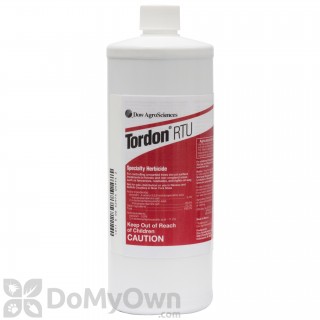
Why DoMyOwn?DoMyOwn.com offers professional-grade insecticides to DIYers while ensuring proper storage of chemicals. Couple that with their impressive customer service and knowledgeable staff, it's the #1 choice.
Effective at killing more than 20 species of woody plants and to prevent the sprouting of cut trees in non-crop areas like forests, roadsides, fence rows, and right-of-ways. It is not meant to be used on residential lawns but can be extremely effective in every environment, particularly when it comes to getting rid of trees after a lot has been cleared.
Since it has a no freeze formulation, it's one of the best products to use in cold weather.
Features and Specs:
- Contains 2,4-D along with triisopropanolamine salt
- Comes ready to use
- Pet-safe when used as directed
Pros:
- Has a blue dye so that you can easily track which stumps you have already treated
- Best for using on cut trees
- Weeds die quickly after application
Cons:
- Should not be used near water
5. Helena Crossbow Herbicide
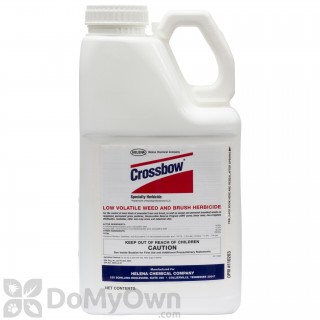
Helena Crossbow Herbicide
2,4-D, butoxyethyl ester 34.4% Triclopyr, butoxyethyl ester 16.5%
Crossbow is a non-selective post-emergent herbicide that targets woody plants and brush such as blackberries and poison oak, as well as annual and perennial broadleaves, while leaving grasses unharmed.
Why DoMyOwn?DoMyOwn.com offers professional-grade insecticides to DIYers while ensuring proper storage of chemicals. Couple that with their impressive customer service and knowledgeable staff, it's the #1 choice.
A nonselective post emergent herbicide, Helena Crossbow is a unique 2,4-D product in that it targets perennial broadleaf weeds along with woody plants and brush, like poison oak. It can be used with all kinds of sprayers and is safe for use around grazing animals.
It is rainfast within two hours after application and while it's not meant to be used on home lawns, it is one of the best options you can use on rangeland, pasture areas, and in wooded environments where weed control is necessary.
Features and Specs:
- Contains 2,4-D in addition to butoxyethyl ester
- Meant to be mixed at a ratio of 1 ⅓- 5 ⅓ oz of water
- Should be applied 1-2 times per year
Pros:
- Rainfast for two hours
- No grazing restrictions
- Can be applied by all kinds of sprayers
Cons:
- Not meant to be used on lawns
6. EndRun Herbicide with Trimec
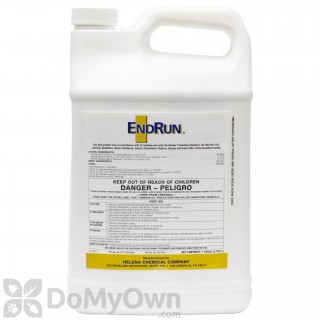
EndRun Herbicide with Trimec
2,4-D, dimethylamine salt 30.56% Dicamba, dimethylamine salt 2.77% MCPP-P, DMA salt 8.17%
EndRun Herbicide is a powerful generic selective post-emergent herbicide that offers the same or better weed control as Trimec 992 or Triplet, using less active ingredient per acre.
Why DoMyOwn?DoMyOwn.com offers professional-grade insecticides to DIYers while ensuring proper storage of chemicals. Couple that with their impressive customer service and knowledgeable staff, it's the #1 choice.
EndRun is a herbicide that can be used to kill all kinds of weeds, including more than 80 different species of broadleaf weeds, including chickweed, henbit, aster, and more. Like some of the other products on this list, it contains other herbicides in addition to 2,4-D, such as dicamba and dimethylamine salt.
It has a pre-loaded surfactant system that will improve your plant uptake and increase its spreading and wetting on the surface of your plants. It also reduces the likelihood that the spray will bounce up and jump to other plants, making it safer to use in most settings.
Features and Specs:
- Covers up to 2.5 acres
- Pet safe when used as directed
- Controls more than 80 species of broadleaf weeds
Pros:
- Highly effective option for bentgrass, perennial ryegrass, bermudagrass, fescue, zoysiagrass, and Kentucky bluegrass
- Requires less active ingredient per acre
- Surfactant makes it a bit safer to use in crowded planting areas
Cons:
- Should not be used on St. Augustine grass
When to Spray
Again, you'll want to consult your package of 2, 4-D weed killer to find out the best timing to apply your product based on the brand. Often, this is in the fall or early summer after certain species of weeds have germinated. Other brands, like Hi-Yield 2, 4-D, require you to apply the product when weeds are small and actively growing, typically in the spring.
You may also need to wait to apply 2, 4-D about six weeks after you have seeded or sodded your lawn so you don't stunt the growth of your grass.
Something that is almost more important than the time of year you spray is the time of day you spray. You will want to wait to apply this herbicide until the soil temperatures of your lawn are lower than 90 degrees Fahrenheit. Applying 2, 4-D, when the weather is hot, can severely damage your grass.
Similarly, you will want to wait for a day with minimal wind. That's because it can kill other plants, like nearby flowers and shrubs, when the breeze picks it up and carries it to nearby areas.
2, 4-D is rainproof up to an hour after application. You can apply it during periods of dry weather without a problem. Also, wait two days after you have sprayed 2, 4-D to mow the lawn.
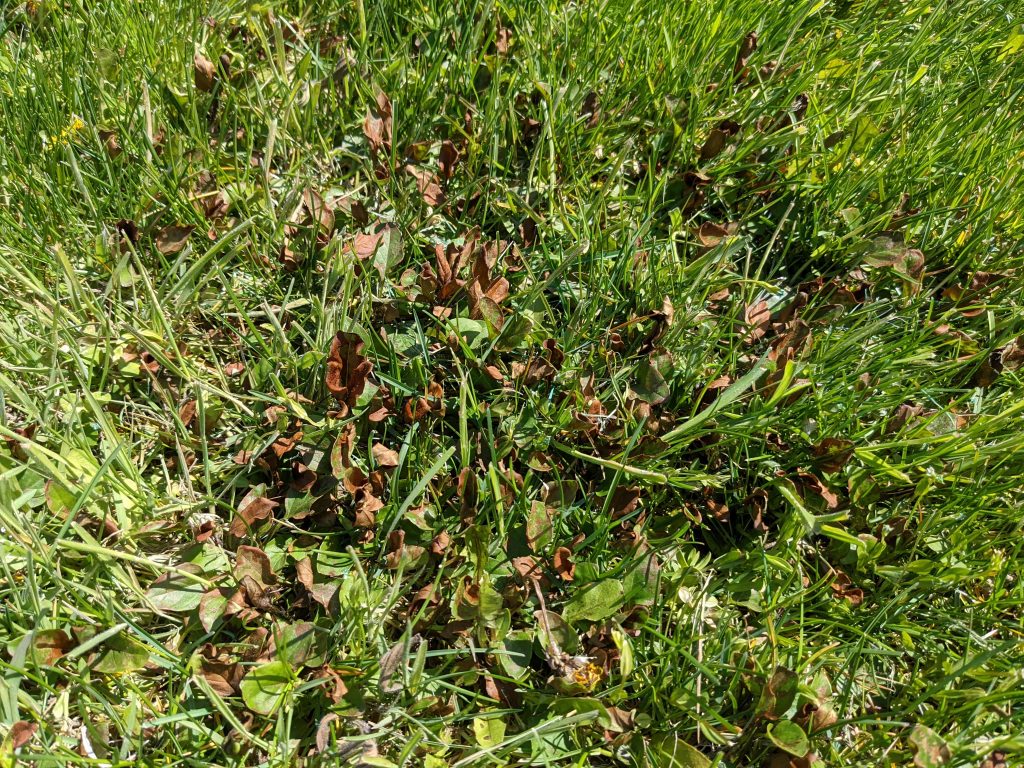
Tips and Warnings
Although 2, 4-D is an effective herbicide, you need to exercise extreme caution when applying it to your lawn. It can be quite toxic if you use the wrong form or do not apply it carefully.
The good news is that this herbicide is low in toxicity in most cases. About 75% of any 2, 4-D your body comes into contact with will leave the body within four days of being exposed.
Pure 2, 4-D is more or less safe should it come into contact with the skin or eyes although it can cause some irritation – the salt and acid forms of 2, 4-D, however, can cause severe eye and digestive irritation (when accidentally ingested). Breathing in 2, 4-D vapors can also cause you some respiratory and neurological distress.
Be careful, when applying 2, 4-D, that you do not let pets or children touch grass or other plants that are wet from spraying. Pets and small children may be more sensitive to the effects of this herbicide.
When it comes to the environment, 2, 4-D may be safer than other types of herbicides. This depends on the form of 2, 4-D you use. Ester forms can be quite toxic to fish and other kinds of aquatic life, but the salt forms offer minimal toxicity. In any event, 2, 4-D is mostly nontoxic to honeybees and other pollinators and beneficial insects – great news if you've been looking for a more environmentally friendly way to take care of the weeds growing on your lawn!
Not all kinds of grass tolerate 2, 4-D herbicide and you shouldn't use it on flowering ornamentals or plants grown for food. Use a different herbicide instead.
Make sure you store leftover 2, 4-D in its original containers and dispose of empty containers in a timely fashion. Don't use it around bodies of water and if you decide to use a dust form of this pesticide, wear a mask when applying it. Of course, wearing gloves when applying this product is always a good idea, too!
Otherwise, 2, 4-D is a solid option for taking care of broadleaf weeds on your lawn. Consider the products listed above for a fast, simple solution for a greener, healthier lawn.
FAQ
How long does it take 2, 4-D weed killer to work?
2, 4-D works rapidly, which is just one reason why it's a favorite herbicide by many homeowners. You will generally notice the effects within mere minutes, with a total browning of the plant occurring in around 48 hours.
Does 2, 4-D kill crabgrass?
Unfortunately, 2, 4-D is not labeled to kill crabgrass or nutsedge. Although these are two kinds of grasses you likely don't want growing on your lawn, they are, of course, both still grasses and won't be eliminated by using 2, 4-D.
How much 2, 4-D does it take to kill dandelions?
In general, the standard application rate of 2.5 oz of weed killer with one gallon of water should be enough to treat 400 square feet of weed-infested yard – and that goes for dandelions, too.
How long does 2, 4-D need to be sprayed before it rains?
Spray 2, 4-D about one hour before it rains (or more). If it is currently raining or rainfall is imminent, you should wait to apply 2, 4-D until the weather is clear to reduce the likelihood of runoff (and to ensure that your application will be effective).
Source: https://princegardening.com/complete-guide-to-2-4-d-weed-killer/
0 Response to "When is the Mix Ratio for Spectrum Liquid Weed and Feed"
Post a Comment